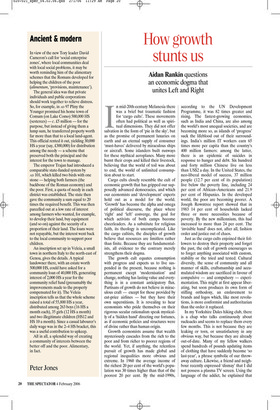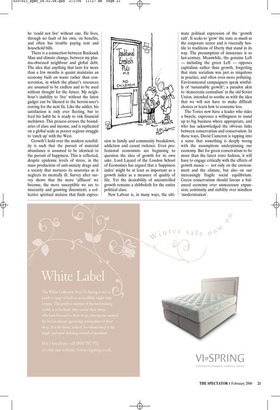How growth stunts us
Aidan Rankin questions an economic dogma that unites Left and Right In mid-20th-century Melanesia there was a brief but traumatic fashion for ‘cargo cults’. These movements often had political as well as spiritual dimensions. They did not offer salvation in the form of ‘pie in the sky’, but as the promise of permanent luxuries on earth and an eternal supply of consumer ‘must-haves’ delivered by miraculous ships or aircraft. Some islanders built runways for these mythical aeroplanes. Many more burnt their crops and killed their livestock, believing that the world of toil was about to end, the world of unlimited consumption about to start.
Cargo cults closely resemble the cult of economic growth that has gripped our supposedly advanced democracies, and which our economists and ‘development’ experts hold out as a model for the world. ‘Growth’ has become the alpha and omega of political discourse, the place where ‘right’ and ‘left’ converge, the goal for which activists of both camps become cheerleaders. As a substitute for religious faith, its theology is uncomplicated. Like the cargo cultists, the disciples of growth believe that resources are limitless rather than finite. Because they are fundamentalists, all evidence to the contrary merely strengthens their dogma.
The growth cult equates consumption with progress and expects us to live suspended in the present, because nothing is permanent except ‘modernisation’ and change, nothing has lasting value and everything is in a constant anticipatory flux. Partisans of growth do not believe in miraculous craft — except for those provided by cut-price airlines — but they have their own superstitions. It is revealing to hear economists who pride themselves on their rigorous secular rationalism speak mystically of a ‘hidden hand’ directing our fortunes, as if economic policies and structures were of divine rather than human origin.
Growth economists assume that wealth mysteriously cascades from the rich to the poor and from richer to poorer regions of the world. Yet, if anything, the relentless pursuit of growth has made global and regional inequalities more obvious and extreme. In 1960 the average income of the richest 20 per cent of the world’s population was 30 times higher than that of the poorest 20 per cent. By the mid-1990s, according to the UN Development Programme, it was 82 times greater and rising. The fastest-growing economies, such as India and China, are also among the world’s most unequal societies, and are becoming more so, as islands of ‘progress’ suck the lifeblood out of their surroundings. India’s million IT workers earn 65 times more per capita than the country’s 400 million farmers: among the latter, there is an epidemic of suicides in response to hunger and debt. Six hundred and forty million Chinese live on less than US$2 a day. In the United States, the neo-liberal model of success, 37 million people (12.7 per cent of its population) live below the poverty line, including 24 per cent of African–Americans and 21.9 per cent of Hispanics. In the developed world, the poor are becoming poorer. A Joseph Rowntree report showed that in 1983 14 per cent of households lacked three or more necessities because of poverty. By the new millennium, this had increased to more than 24 per cent. The ‘invisible hand’ does not, after all, fashion order and justice out of chaos.
Just as the cargo cults enjoined their followers to destroy their property and forget the past, the cult of growth encourages us to forget anything associated with custom, stability or the tried and tested. Cultural diversity, the sense of community and all manner of skills, craftsmanship and accumulated wisdom are sacrificed in favour of compulsive — and compulsory — experimentation. This might at first appear liberating, but soon produces its own form of stifling orthodoxy, an enslavement to brands and logos which, like most revolutions, is more conformist and authoritarian than the order it replaced.
In my Yorkshire Dales hiking club, there is a chap who talks continuously about rucksacks and seems to replace them every few months. This is not because they are leaking or torn, or unsatisfactory in any obvious way, but because they are already out-of-date. Many of my fellow walkers spend hundreds of pounds updating items of clothing that have suddenly become ‘so last-year’, a phrase symbolic of our throwaway culture. Likewise, a friend and neighbour recently expressed ‘dismay’ that I did not possess a plasma TV screen. Using the language of the addict, he explained that he ‘could not live’ without one. He lives, through no fault of his own, on benefits, and often has trouble paying rent and household bills.
There is a connection between Rucksack Man and climate change, between my plasma-obsessed neighbour and global debt. The idea that anything that lasts for more than a few months is quaint maintains an economy built on waste rather than conservation, in which the planet’s resources are assumed to be endless and to be used without thought for the future. My neighbour’s inability to ‘live’ without the latest gadget can be likened to the heroin-user’s craving for the next fix. Like the addict, his satisfaction is only ever fleeting, but to feed his habit he is ready to risk financial meltdown. This process crosses the boundaries of class and income, and is replicated on a global scale as poorer regions struggle to ‘catch up’ with the West.
Growth’s hold over the modern sensibility is such that the pursuit of material abundance is assumed to be identical to the pursuit of happiness. This is reflected, despite epidemic levels of stress, in the mass production of anti-anxiety drugs and a society that nurtures its neurotics as it neglects its mentally ill. Survey after survey shows that the more ‘affluent’ we become, the more susceptible we are to insecurity and gnawing discontent; a collective spiritual malaise that finds expres sion in family and community breakdown, addiction and casual violence. Even professional economists are beginning to question the idea of growth for its own sake. Lord Layard of the London School of Economics has argued that a ‘happiness index’ might be at least as important as a growth index as a measure of quality of life. Yet the desirability of uncontrolled growth remains a shibboleth for the entire political class.
New Labour is, in many ways, the ulti mate political expression of the ‘growth cult’. It seeks to ‘grow’ the state as much as the corporate sector and is viscerally hostile to traditions of liberty that stand in its way. The presumption of innocence is so last-century. Meanwhile, the genuine Left — including the green Left — opposes capitalism rather than growth, forgetting that state socialism was just as iniquitous in practice, and often even more polluting. Environmental campaigners speak wistfully of ‘sustainable growth’; a paradox akin to ‘democratic centralism’ in the old Soviet Union, intended to soothe us with the idea that we will not have to make difficult choices or learn how to consume less.
The Tories now have a leader who rides a bicycle, expresses a willingness to stand up to big business where appropriate, and who has acknowledged the obvious links between conservatism and conservation. In these ways, David Cameron is tapping into a sense that something is deeply wrong with the assumptions underpinning our economy. But for green conservatism to be more than the latest retro fashion, it will have to engage critically with the effects of growth mania — not only on the environment and the climate, but also on our increasingly fragile social equilibrium. Green conservatism should favour a balanced economy over unnecessary expansion, continuity and stability over mindless ‘modernisation’.






























































































































 Previous page
Previous page